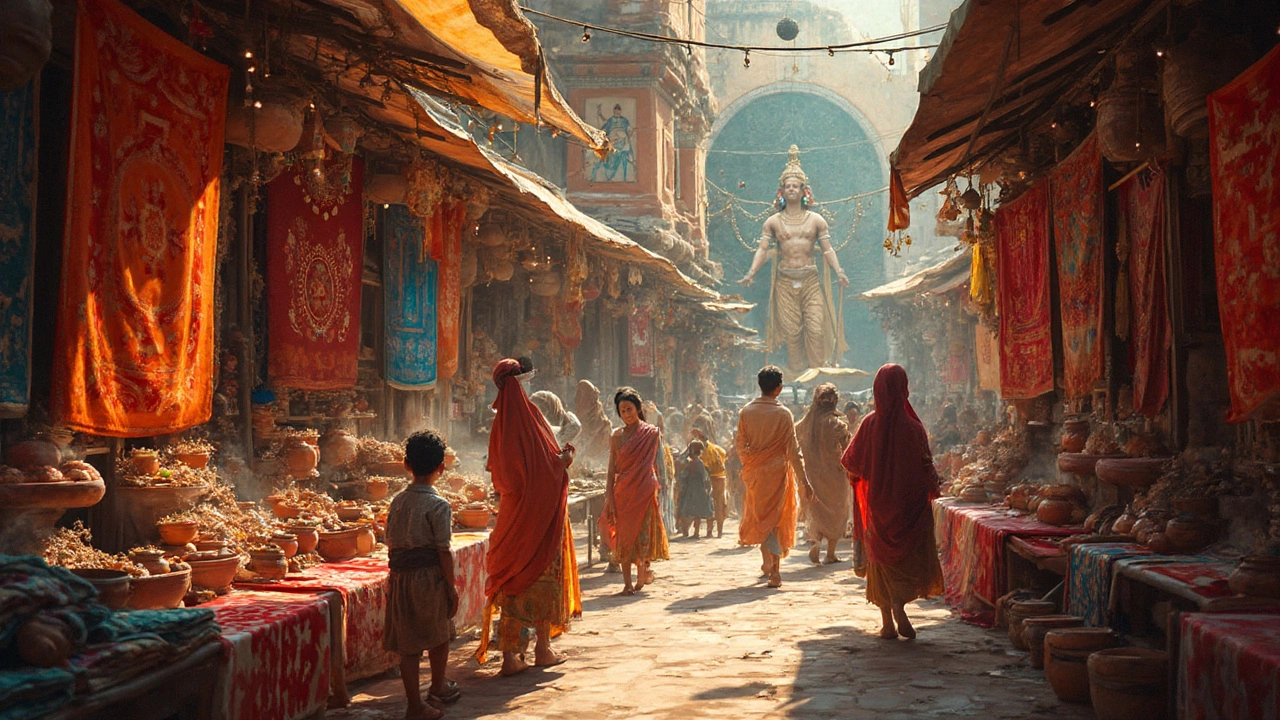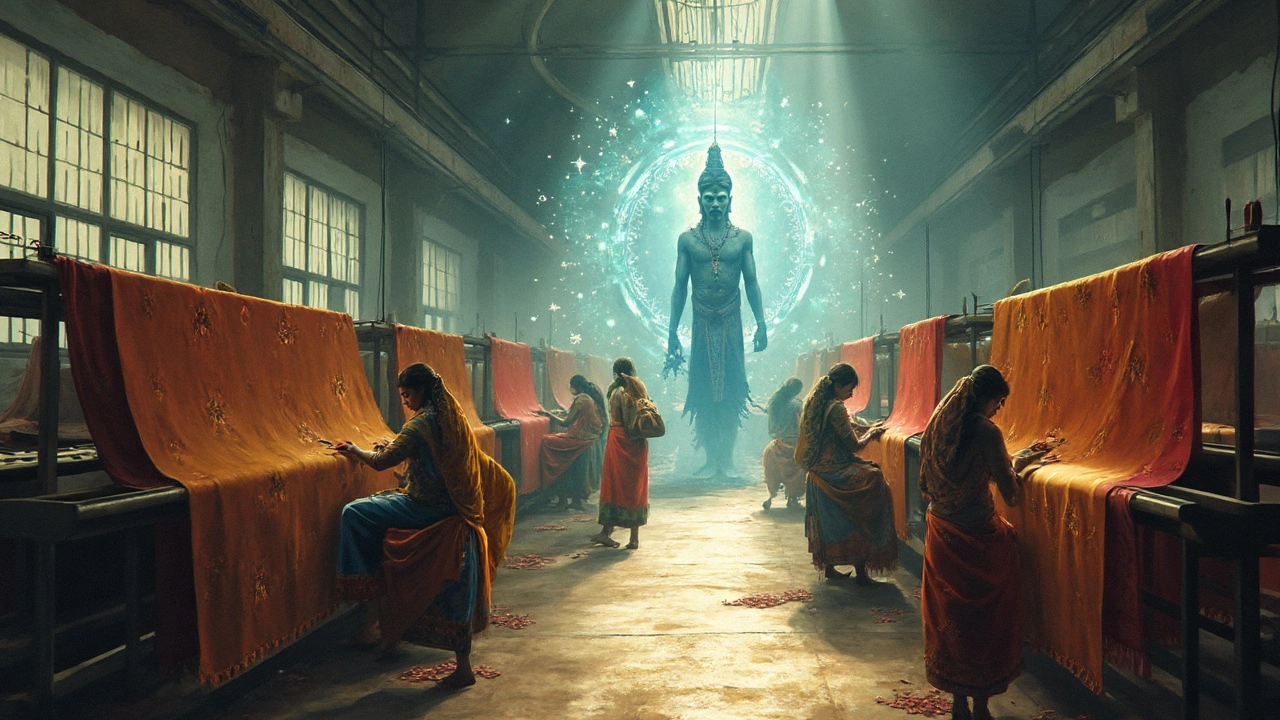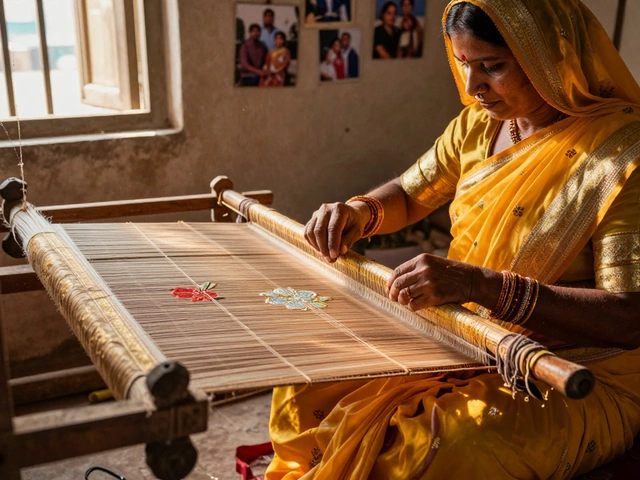Indian God of Textiles: History, Culture, and Industry Ties

The story of Indian textiles is full of rich color, age-old legends, and surprising connections to the divine. India isn’t just the land of cotton and silk—some folks even believe that gods weave their own magic into every thread. But is there really an official 'god of textiles' in India?
If you run a textile business or even just love beautiful fabrics, getting to know the cultural roots can make your work or shopping way more interesting. India’s weaving traditions stretch back thousands of years, and they’re often wrapped up in spiritual stories told around family looms and factory floors alike. Most people are shocked to learn that while there isn’t one single “textile god” for all of India, some deities are tightly woven into textile communities. A lot of this has to do with the way textiles grew in different parts of the country—think of it as a patchwork, not a single sheet.
- Textiles in Indian History: A Quick Look
- Is There an Indian God of Textiles?
- Popular Deities Linked to Weaving and Fabric
- Why These Myths Still Matter to Manufacturers
- Modern-Day Practices and Rituals
- Tips for Spotting Textile Traditions Today
Textiles in Indian History: A Quick Look
India’s relationship with textiles goes way back—older than most written records. Archaeologists found cotton threads in the Indus Valley sites, which means people here were spinning and weaving as far back as 2500 BCE. Fast-forward a bit and you’ll see Indian cloth mentioned in old Egyptian tombs and Roman records. They weren’t just trading it locally; Indian fabrics were heavily exported across Asia, Africa, and Europe for centuries.
The variety is pretty wild. Cotton, silk, and wool all played a big part, and each region developed its own style—think Banarasi sarees in the north, Kanjeevaram silk in the south, and Pashmina shawls from Kashmir. The real kicker? These styles haven’t died out; they’re still a huge deal at weddings and festivals today.
Weaving has always meant more than just making clothes. For many Indian communities, it was a family business, passed down through generations, often tied up with caste or community identity. Some towns even owe their whole existence to textile production—like Surat for silk or Panipat for carpets. When you talk to older folks in those areas, you’ll hear stories about weaving that sound almost like family legends.
The numbers show how big the industry still is:
| Type | Approximate Historic Period | Main Areas |
|---|---|---|
| Cotton | 2500 BCE onwards | Gujarat, Maharashtra, Tamil Nadu |
| Silk | 2700 BCE onwards | Karnataka, West Bengal, Assam |
| Wool | Ancient period | Kashmir, Himachal Pradesh, Rajasthan |
Even today, India is one of the world’s biggest producers and exporters of fabrics. The Indian god of textiles may be debated, but nobody misses how important textiles are to the country’s culture and economy. And with so many craftspeople still in the game, these ancient skills aren’t going anywhere.
Is There an Indian God of Textiles?
So, is there an official Indian god that everyone calls the “god of textiles”? Not really. India’s culture is huge and complicated, and each region tends to have its own ideas about which deity watches over textile work. There’s no single calendar date or festival that honors a universal fabric god in India. But that doesn’t mean those threads aren’t tied to something special.
Some weaving groups and textile towns do connect their craft with certain deities for good luck, skill, and prosperity. Here are the ones you’ll hear about most often:
- Lord Vishwakarma: Known as the divine architect and craftsman, he’s the big name in factories and workshops, including textile mills. Many textile manufacturers celebrate Vishwakarma Puja, hoping his blessings will make their machines run smoothly and keep workers safe.
- Goddess Saraswati: People link her with learning and creativity. Some weavers start new projects after a small ritual to her, wishing for steady hands and fresh ideas.
- Goddess Lakshmi: Seen as the bringer of wealth, she’s often thanked after successful trade or a good batch of fabric. Clothing store owners and silk producers put her images in shops for prosperity.
In the south, the community of Padmashalis—traditional weavers—trace their roots to sage Markanda, believed to be sent by the gods to start the weaving trade. In Odisha, the goddess Maa Dhamarai is worshipped by weavers for protection and steady work.
| Deity | Role in Textiles | Celebrated by |
|---|---|---|
| Vishwakarma | Patron of all craft, tools, and machinery | Textile manufacturers, weavers across India |
| Saraswati | Inspires creativity and skill | Weavers, design students, artisans |
| Lakshmi | Blesses business with prosperity | Shop owners, silk merchants |
| Maa Dhamarai | Protector of weavers in Odisha | Weaver communities in coastal Odisha |
So, while there isn’t one clear “Indian god of textiles,” plenty of deities, especially Vishwakarma, have a foot in the textile world. This patchwork of faith gives every region and weaving family a unique connection to their craft.
Popular Deities Linked to Weaving and Fabric
India might not have one single official god or goddess of textiles, but several deities are seen as protectors or patrons by weaving communities. Different regions have their favorites, thanks to traditions passed down over generations. If you're trying to spot links between faith and fabric, here are some key names you’ll run into.
Goddess Lakshmi is especially big in textile hubs. She’s usually seen as the goddess of wealth and prosperity, and weaving families often credit her for their skills and the fabric they produce. In places like Varanasi and Surat, manufacturers offer the first piece of every new weave to her during special prayers—believing it brings success and good luck.
Saraswati, the goddess of wisdom and arts, also shows up a lot. Some old weaving workshops keep her image around for inspiration, especially when launching new patterns or experimenting with design. There’s a belief that without her blessings, creativity just dries up. The city of Kanchipuram, famous for silk sarees, even holds an annual festival to honor her.
Now, here’s an interesting piece—across parts of South India, Vishwakarma is actually called the divine architect. He’s the “go-to” god for craftsmen, weavers, and artisans. Many textile manufacturers, especially in Tamil Nadu and Karnataka, celebrate Vishwakarma Puja every year right on the factory floor. They stop all work for the day, worship the tools, and hand out sweets to every worker.
"For people in my village, we start every loom with a prayer to Vishwakarma. It’s as normal as having breakfast," said Ramachandran, a veteran handloom weaver in Erode, quoted in The Hindu.
What’s cool is that these traditions aren’t just for small family businesses. Even big plants sometimes decorate their halls with images or statues of these deities. Owners and workers see it as a way to keep their roots strong and the business running smooth.
- If you visit weaving towns, notice which god or goddess has the most flower garlands or faded posters in workshops. That’s usually the community’s textile patron.
- During big festivals, local markets often run unique sari sales or fabric fairs, directly tied to these worship rituals.

Why These Myths Still Matter to Manufacturers
So, why do busy textile manufacturers in India still care about old myths and gods? It’s not just nostalgia. For a lot of textile producers, these stories help explain why certain places are famous for making special kinds of fabric. They also give a sense of identity to workers who might spend years weaving or dyeing cloth.
Take the Indian god of textiles idea. Whether it’s the goddess Lakshmi for prosperity, Vishwakarma for craftsmanship, or local gods like Lord Jagannath in Odisha, these beliefs sit at the heart of daily life in many factories and villages. For example, it’s common for weavers' guilds in Varanasi or Kanchipuram to celebrate sacred festival days with rituals—some even keep small shrines right inside the warehouse. On Vishwakarma Jayanti, machines get decorated and nobody works till a quick prayer is done, hoping for smooth business and fewer breakdowns.
This isn’t just superstition. Some textile firms report that honoring these rituals keeps morale high and teams united. When workers feel their craft is part of something bigger, it actually boosts motivation and loyalty. You’ll also notice that local myths shape branding—many saree labels proudly show a goddess or temple, tying culture to product.
International buyers look for these stories, too. Brands from outside India love showing off the tradition behind Indian fabrics, so knowing the legends can help manufacturers stand out and add value to their goods. Plus, some government schemes promote traditional craft clusters based around famous myth-linked towns—so there are real business perks to keeping these stories alive.
Bottom line: if you want to build trust and spark pride within your factory teams, or attract clients who care about heritage, don’t ignore the myth side of things. It’s still part of the secret sauce that makes Indian textiles unique.
Modern-Day Practices and Rituals
Walk into any big textile hub in India—like Surat for silk or Tiruppur for cotton—and you’ll notice that business and traditions mix every single day. Factories and small workshops might look techy with their machines and production lines, but they’re often dotted with tiny shrines or pictures of gods. Offering prayers before starting a loom or spinning machine isn’t a rare scene. Most textile families believe it keeps their business safe and quality high.
The most common rituals start in the morning. Factory owners and workers might light incense, place fresh flowers, or even do a quick coconut-breaking ceremony before the first shift. During big festivals like Diwali or Pongal, some manufacturers stop work entirely for a day and hold group prayers to thank the gods for good sales and safe work throughout the year. When they buy new machinery or launch a new textile line, they’ll often invite a priest for a blessing ceremony right in the workspace.
Certain regions stand out for their unique customs. In the handloom towns of West Bengal, many weavers pray to Goddess Saraswati before every busy season starts. Down south, especially among silk weavers, Goddess Lakshmi gets special attention—her image is easy to spot above looms or cash registers. Some dyeing units in Gujarat even have miniature temples set up just for rituals related to colors and dyes.
One tip if you’re visiting a Indian god of textiles region: take a look at the calendar. Most local markets close or open late on days considered lucky or sacred, especially during Navratri or Sankranti. Workers don’t just follow these rituals out of habit—many believe it really impacts the quality and success of what they make. This blend of faith and manufacturing isn’t just about nostalgia, either; for lots of textile communities, it’s a way to bring everyone together and focus on the year’s goals.
- Look out for fresh flower garlands at weaving looms or dye vats.
- If you’re sourcing fabric, ask about their festival rituals—you’ll usually get a story about luck, family, or a legendary festival mishap.
- Some manufacturers host lunch feasts to celebrate a good production run or a major contract, all starting with a quick prayer.
Spotting these small traditions gives you a window into the real working culture behind all those vibrant Indian fabrics. Whether you’re a buyer, a tourist, or a proud local, it’s easy to see how old stories and modern business keep weaving together—no pun intended.
Tips for Spotting Textile Traditions Today
India’s textile scene looks modern on the outside, but peek a little closer and you’ll find old traditions stitched right in. If you ever visit a weaving town or scroll through Indian fabrics online, you can actually spot bits of history and culture baked into the fabric. Here’s how to spot those classic signs, whether you’re shopping at a street market or checking a tag in a major brand store.
- Indian god of textiles signatures: Look for motifs showing gods like Vishwakarma (the 'divine architect') on festival textiles, or images of Lakshmi on embroidered saris, especially during Diwali. Some weaving communities still leave a thread untouched at the beginning or end of a piece as a good luck gesture—keep an eye out for that!
- Handloom clues: Real handwoven cloths, like Chanderi or Kanchipuram silks, usually have a small flaw or uneven spot—that’s the weaver’s mark, not a defect. This is often considered a sign of authenticity and pride in Indian textile culture.
- Region-specific touches: If a fabric boasts peacock or lotus patterns, it might be from Gujarat or Rajasthan. Temple borders on saris usually mean South Indian origin, especially Tamil Nadu and Andhra Pradesh.
- Special days and rituals: On Vishwakarma Jayanti, textile factories often shut for a day and hold a puja (ritual) for their looms and tools. If you see an idol near the entrance of a workshop, it’s probably Vishwakarma or Lakshmi watching over the process.
Here’s a quick table breaking down common textile styles and their signature tradition or deity:
| Textile Style | Region | Tradition or Deity |
|---|---|---|
| Banarasi Silk | Varanasi, Uttar Pradesh | Worship of Ganga river and Vishwakarma |
| Kanchipuram Silk | Tamil Nadu | Temple motifs, Lakshmi |
| Patola | Gujarat | Shreenathji, local temple blessings |
| Pochampally Ikat | Telangana | Village deity rituals |
If you’re really curious, ask vendors at fairs or markets about designs or rituals—they’ll usually be happy to explain how a fabric connects back to their family or faith. Even big-name Indian textile manufacturers often frame certificates or photos of Vishwakarma at the office, showing that the old ways still thread through the new.





